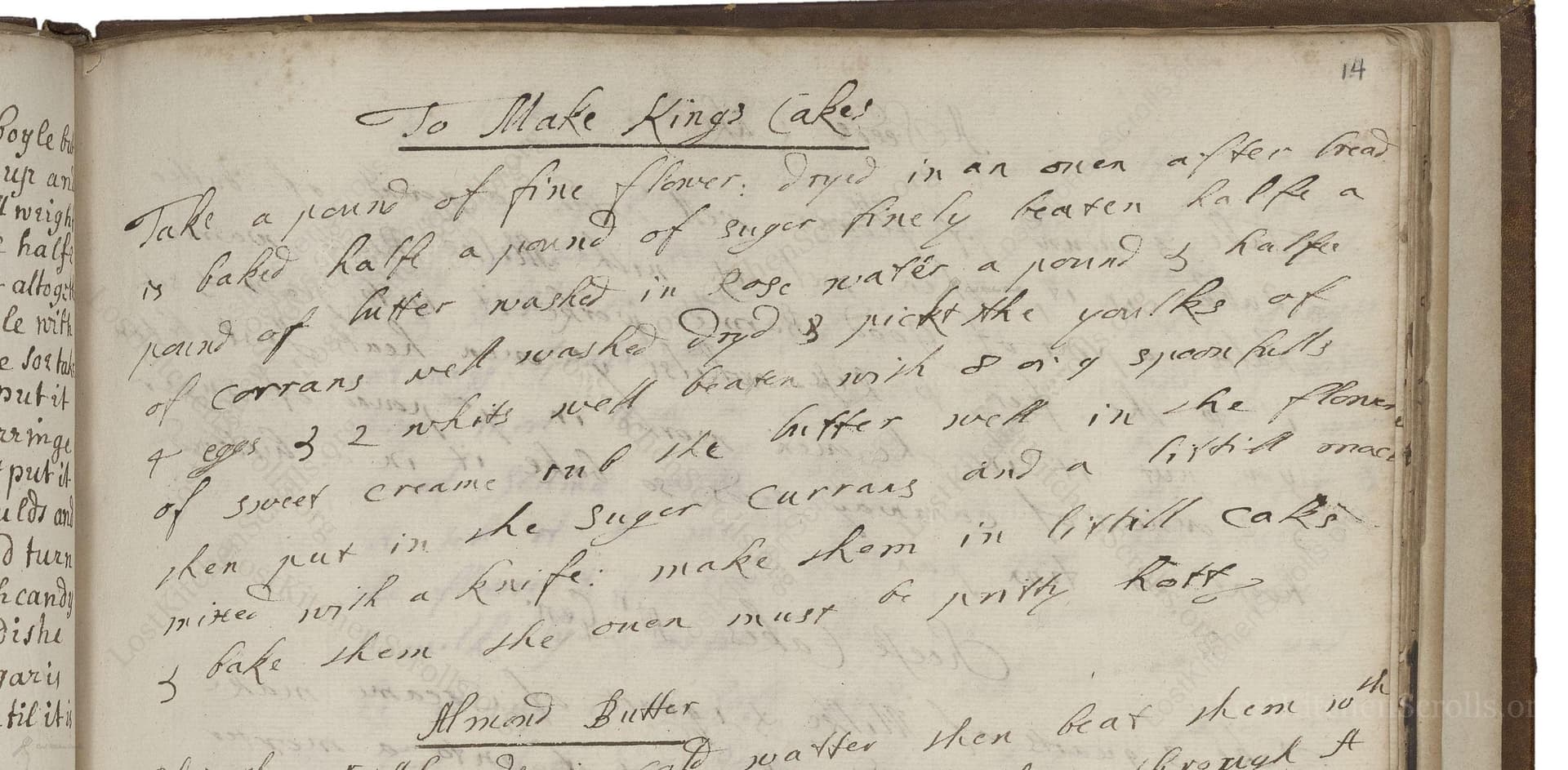To Make Kings Cake
From the treasured pages of Receipts in cookery and medicine 1700
Unknown Author

To Make Kings Cake
"Take a pound of fine flower. dryd in an oven after bread is baked halfe a pound of suger finely beaten halfe a pound of butterr washed in Rose water a pound & halfe of corrans well washed and dry'd 8 eges 2 whits well beaten with 8 or 9 spoonfulls of sweet creame rub the butterr well in the flower then put in the suger Currans and a little mace then put in the eges and mix with a knife: make them in little cakes & bake them the oven must be pritty hott."
Note on the Original Text
The recipe is brief and assumes some knowledge, listing ingredients in the order used and describing actions plainly. Spelling reflects period conventions—'eges' for eggs, 'flower' for flour, 'suger' for sugar, 'corrans' for currants. Quantities use pounds, spoons, and descriptive baking temperatures like 'pritty hott' for ovens. Use of terms like 'rub the butter well in the flower' reflects historical mixing techniques intended to achieve light, even texture without modern mechanical aids.

Title
Receipts in cookery and medicine 1700 (1700)
You can also click the book image above to peruse the original tome
Writer
Unknown
Era
1700
Publisher
Unknown
Background
Step into the kitchen of the early 18th century, where this charming culinary manuscript tempts tastebuds with recipes and secrets from a bygone era. A delicious journey for both the curious cook and the history lover.
Kindly made available by
Folger Shakespeare Library
This recipe comes from circa 1700, a period when festive cakes were an important part of English celebration, especially around Twelfth Night and Epiphany. "King's Cake" would have been served to mark the end of the Christmas season, often enjoyed by both gentry and middling households. The recipe predates baking powder and relies on eggs for leavening. The lavish quantity of currants and rich mix of butter and cream reflects the dish’s status as a celebratory treat, designed to be shared and enjoyed at feasts or special gatherings.

Cooks in the early 18th century used large wooden or pewter mixing bowls, with flour sifted and dried using wooden sieves and hot bread ovens. The butter might have been washed in rose water in a shallow pan or dish and then rubbed into flour by hand. Ingredients would be mixed with large knives rather than spoons for lightness. The cakes were shaped by hand and baked in 'a pretty hot' (moderately hot) wood-fired oven, often on thick iron or earthenware baking sheets.
Prep Time
30 mins
Cook Time
20 mins
Servings
18
We've done our best to adapt this historical recipe for modern kitchens, but some details may still need refinement. We warmly welcome feedback from fellow cooks and culinary historians — your insights support the entire community!
Ingredients
- 1 lb (16 oz) plain (all-purpose) flour, sifted and dried
- 8 oz (1 cup) caster sugar
- 8 oz (1 cup or 2 sticks) unsalted butter, softened
- 1 tablespoon rose water (optional; for washing butter or added to batter)
- 1 1/2 lbs (24 oz/about 3 cups) currants (or substitute chopped raisins if currants unavailable)
- 8 large eggs and 2 egg whites
- 1/2 to 2/3 cup (8-9 tablespoons) double cream (sweet)
- 1/2 teaspoon ground mace
Instructions
- To make King's Cake today, start by sifting 1 pound (16 ounces) of plain flour, then dry it in a very low oven for 10 minutes, allowing it to cool completely.
- In a mixing bowl, rub in 8 ounces (1 cup or 2 sticks) of unsalted butter (softened and, for floral aroma, optional 1 tablespoon rose water) until it resembles breadcrumbs.
- Add 8 ounces (1 cup) of caster sugar, 1 1/2 pounds (24 ounces, about 3 cups) of currants (thoroughly washed and patted dry), and a generous pinch (about 1/2 teaspoon) of ground mace.
- In another bowl, beat 8 eggs plus 2 egg whites until frothy, then mix in 8 to 9 tablespoons (about 1/2 to 2/3 cup) of double cream.
- Pour the egg mixture into the dry ingredients and, using a knife, mix everything together until evenly combined.
- Shape into small cakes or rounds on baking trays lined with parchment.
- Bake in a preheated oven at 400°F (fan 375°F) for 15-20 minutes, or until lightly golden and set.
Estimated Calories
320 per serving
Cooking Estimates
It takes about 25-30 minutes to get all your ingredients ready and make the dough. Baking the cakes in the oven takes about 15-20 minutes. Each cake has around 320 calories, and this recipe makes 18 servings.
As noted above, we have made our best effort to translate and adapt this historical recipe for modern kitchens, taking into account ingredients nowadays, cooking techniques, measurements, and so on. However, historical recipes often contain assumptions that require interpretation.
We'd love for anyone to help improve these adaptations. Community contributions are highly welcome. If you have suggestions, corrections, or cooking tips based on your experience with this recipe, please share them below.
Join the Discussion
Rate This Recipe

Den Bockfisch In Einer Fleisch Suppen Zu Kochen
This recipe hails from a German manuscript cookbook compiled in 1696, a time whe...

Die Grieß Nudlen Zumachen
This recipe comes from a rather mysterious manuscript cookbook, penned anonymous...

Ein Boudain
This recipe comes from an anonymous German-language manuscript cookbook from 169...

Ein Gesaltzen Citroni
This recipe, dating from 1696, comes from an extensive anonymous German cookbook...
Browse our complete collection of time-honored recipes



